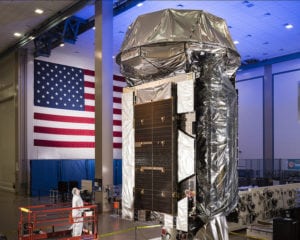Latest News

MUOS 5 at Lockheed Martin’s Sunnyvale, California satellite manufacturing facility. Photo: Lockheed Martin
[Via Satellite 06-23-2016] The U.S. Navy and Lockheed Martin are ready to launch the fifth Mobile User Objective System (MUOS) secure communications satellite, MUOS 5, at Cape Canaveral, Florida on Friday, June 24, aboard a United Launch Alliance Atlas 5 rocket. The launch window is between 10:30 a.m. and 11:14 a.m. EDT.
For the Navy, MUOS 5 completes a network of orbiting satellites and relay ground stations aimed at improving secure communications for mobile military forces. Users with MUOS terminals will be able to seamlessly connect beyond line-of-sight around the world and into the Global Information Grid, as well as into the Defense Switching Network.
“Users of the legacy satellite communications system can talk, but they are limited to conversations between users under the footprint of the same satellite,” explains Mark Woempner, director of Lockheed Martin’s Narrowband Communications Systems. “MUOS is a game-changer for our forces, establishing a global military cellular network through which they can reach out to each other — and exchange mission data — almost anywhere around the world.”
MUOS 5 joins a network of four already-on-orbit MUOS satellites and four operational relay ground stations, providing near-global coverage, including communications reach deep into Polar Regions. Like its predecessors, the MUOS 5 satellite has two payloads to support both these new Wideband Code Division Multiple Access (WCDMA) waveform capabilities, as well as the legacy Ultra High Frequency (UHF) satellite system. MUOS 5 will augment the constellation as a WCDMA spare, while actively supporting the legacy UHF system, currently used by many mobile forces today.
Once fully operational, the MUOS network will provide users with 16 times more communications capacity than the legacy system it will eventually replace. More than 55,000 currently fielded radio terminals can be upgraded to be MUOS-compatible, with many of them requiring just a software upgrade.
Get the latest Via Satellite news!
Subscribe Now